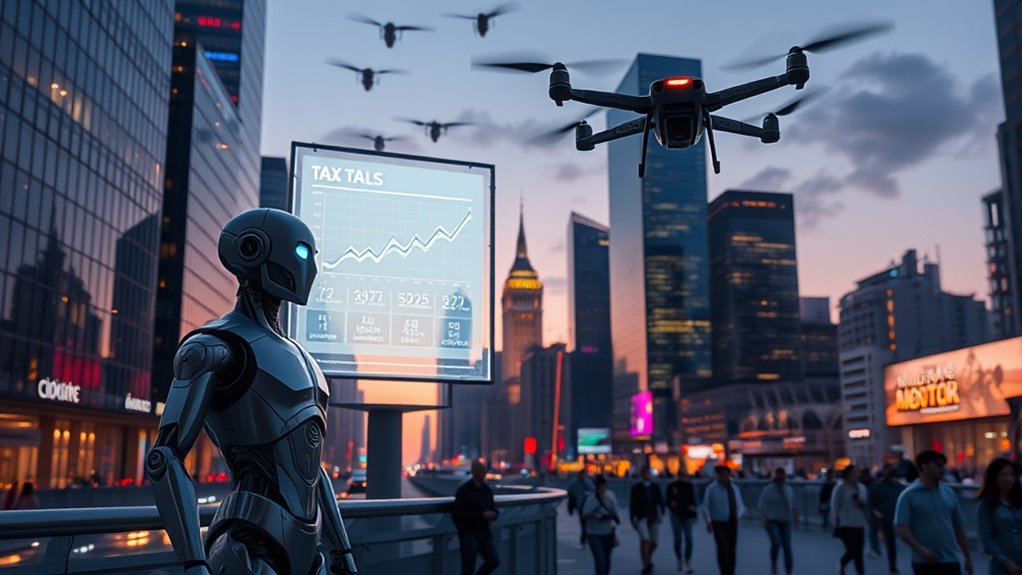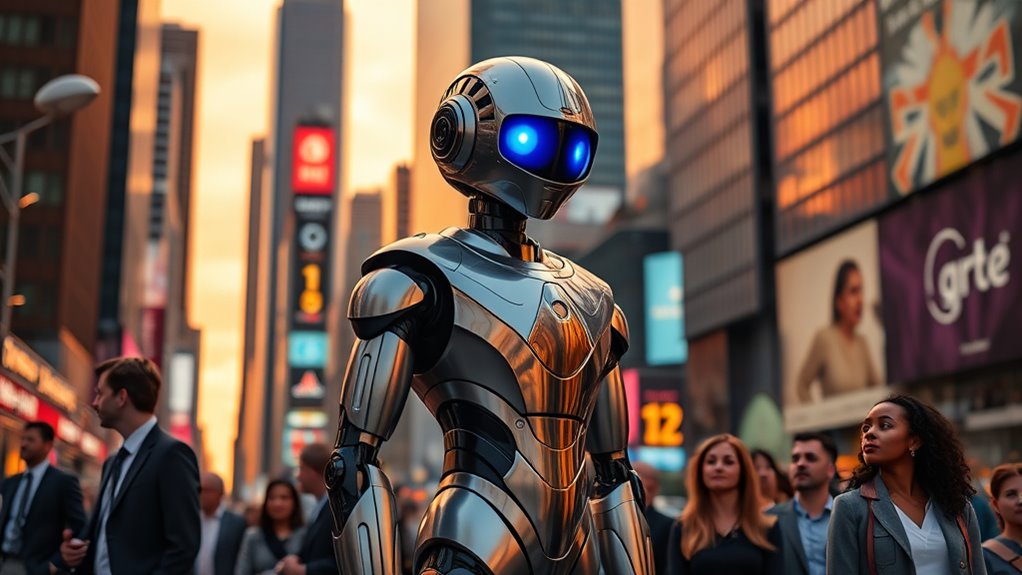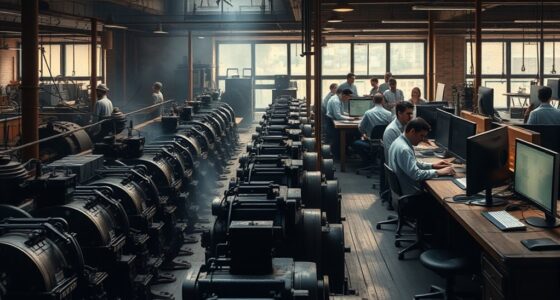Taxing robots can help fund social safety nets strained by automation and job displacement. As automation accelerates, governments see potential revenue from robot taxes to cover programs like healthcare and unemployment benefits. While defining and implementing these taxes pose challenges, international coordination and thoughtful policies can make it effective. If you’re curious about how this approach could work and its potential impact, there’s more to explore below.
Key Takeaways
- A robot tax could generate revenue to help fund social safety nets amid increasing automation.
- It can incentivize companies to balance human labor and automation, supporting job transitions and safety programs.
- Taxing automation may offset revenue losses from reduced traditional taxes and sustain programs like Social Security.
- Implementing a robot tax faces challenges in defining taxable robots, legal issues, and international policy coordination.
- Revenue from robot taxes could be invested in retraining, unemployment benefits, and other social safety initiatives.
Understanding the Current Tax System and Its Challenges

To understand the current U.S. tax system, it’s important to recognize its main components and the challenges they face. You have personal income taxes, corporate taxes, payroll taxes, and property taxes that fund government programs like Social Security and Medicare. Federal income tax rates range from 10% to 37%, with higher rates for wealthier earners. Recent tax cuts, such as in 2017, reduced revenue substantially, impacting government budgets. Many provisions from these cuts are set to expire, creating uncertainty. The system also influences the economy, sometimes boosting GDP but often exacerbating income inequality. Tax policies tend to favor higher-income groups, leaving low-income individuals less affected. These challenges complicate reform efforts and raise questions about how to create a fair and sustainable tax system. The system’s structure often benefits the wealthy disproportionately, further deepening economic and racial disparities. Additionally, addressing the issue of tax evasion could help improve revenue and fairness in the system.
The Rationale Behind a Robot Tax and Its Objectives

The rationale behind a robot tax centers on addressing the economic and social shifts caused by automation. You’re likely aware that automation displaces workers, so a robot tax offers financial support during these periods of change. It encourages companies to strike a balance between human labor and automation, maintaining a healthy market and consumer demand. Legally, assigning personality to robots helps create a structured basis for taxation and ethical oversight. The tax also aims to guarantee fairness by balancing taxation between labor and capital, preventing companies from avoiding taxes. Additionally, it helps offset revenue lost from automation, funding crucial public services like healthcare and education. Such measures are increasingly supported by policymakers worldwide to ensure equitable growth. Overall, a robot tax is designed to promote economic stability, support displaced workers, and uphold ethical and legal standards in a rapidly changing technological landscape.
Analyzing the Economic Effects of Automation and Tax Strategies

Automation boosts productivity and cuts costs, but it also displaces jobs and changes economic dynamics. Considering a robot tax could help fund social programs, yet it raises legal and economic challenges. Examining these effects helps you understand how tax strategies might balance innovation with societal needs. For instance, implementing a tax on automation could incentivize responsible adoption of new technologies while generating revenue to support displaced workers.
Automation’s Economic Impact
As automation continues to reshape industries, its economic impact becomes increasingly complex and multifaceted. It fuels growth, with the industrial automation market projected to hit $226.8 billion by 2025 and grow at 10.8% annually through 2030. Asia-Pacific leads, capturing about 39% of revenue, while over 60% of companies have adopted automation. However, job displacement looms—up to 92 million jobs could be lost by 2030, especially in manufacturing and creative sectors. Despite this, a net gain of 78 million new jobs is expected. Automation boosts productivity, reduces costs, and accelerates revenue growth. This dynamic creates a landscape where economic benefits must be balanced with job transition strategies and innovative funding models, including potential robot taxes, to sustain growth and social stability. Understanding the traits of different personality types can also play a role in adapting to these changes and fostering resilience.
Robot Tax Strategies
Governments and policymakers are exploring various strategies to manage the economic impacts of increasing automation, with robot taxes emerging as a prominent proposal. You should consider that:
- Imposing taxes on robot purchases or software licenses could discourage automation but might overlook in-house developments.
- Assessing robots’ value for taxation faces challenges due to intangible assets and unique designs, complicating implementation.
- Taxing the output of robots resembles corporate income taxes but risks redundancy, making it less effective.
- Balancing robot taxes with subsidies could encourage innovation initially, but increased adoption may lead to higher tax burdens, risking economic efficiency.
- Understanding the composition techniques used in trailer music can inform how automation might influence creative industries.
While these strategies aim to preserve jobs and revenue, their complexity and potential distortions demand careful design.
How Social Safety Nets Are Evolving in an Automated Workforce

As automation displaces jobs across industries, you’ll see social safety nets evolving to better support displaced workers through retraining and new benefits. These programs face funding challenges, prompting discussions around innovative solutions like robot taxes and value redistribution. Adapting safety nets quickly is essential to ensuring workers aren’t left behind in the automated economy. Policies also need to address the impact of AI on employment to prepare for the workforce restructuring, including understanding the characteristics of a healthy breakfast that can help workers maintain their well-being during transitions.
Automation’s Impact on Employment
Automation is transforming the workforce rapidly, forcing social safety nets to adapt to a new economic landscape. You might feel anxious knowing that AI could replace 300 million jobs globally, impacting 9.1% of all jobs worldwide. But, on the bright side:
- 92 million jobs will be displaced by automation by 2030, yet 170 million new roles will emerge. However, the net gain of 78 million jobs indicates that economic restructuring may offset some losses.
- 14% of workers could need to change careers, affecting 375 million people globally.
- Sectors like manufacturing, customer service, and clerical work are most vulnerable to automation.
- Nearly half of workers (44%) will require reskilling within five years, but only 8% of companies are prepared.
While automation causes disruption, it also creates opportunities for new employment and economic growth—if we adapt quickly.
Expanding Social Safety Programs
To effectively support workers affected by automation, social safety nets must evolve beyond traditional models. You’ll need more flexible programs that provide financial support during unemployment and promote retraining for displaced workers. In regions with high robot adoption, enhanced unemployment insurance helps workers find better job matches and offsets wage declines. Social assistance programs also play a vital role in alleviating increased poverty in highly automated areas. As automation reshapes the workforce, these programs must accommodate non-traditional jobs like gig work and contract roles, which often lack benefits. They should also address income volatility and support geographic mobility. Building a holistic safety net ensures workers can transition smoothly, access lifelong learning, and remain resilient in a rapidly changing labor market. Incorporating innovative solutions such as electric bikes can provide affordable transportation options for displaced workers seeking new opportunities.
Funding Challenges and Solutions
The rise of automation presents significant funding challenges for social safety nets, as traditional revenue sources struggle to keep pace with changing economic realities. You face the reality that:
- Rising costs due to more beneficiaries and an aging population threaten program sustainability.
- Revenue shortfalls, like Social Security’s trust fund, could deplete by 2034, risking your security.
- Economic downturns reduce contributions, making funding even harder.
- Proposed cuts to programs like Medicaid and SNAP threaten essential support you rely on. Furthermore, the program’s financial outlook indicates a shortfall of 3.82% of taxable payroll over 75 years, with the trust fund unable to fully meet benefit payments by 2034, highlighting the urgent need for innovative funding solutions such as taxing automation-related income. Additionally, exploring alternative revenue sources like automation taxes could be crucial in bridging the funding gap.
Policy Hurdles and International Perspectives on Robot Taxation

Implementing a robot tax faces complex policy hurdles and requires careful international coordination. You’ll need clear definitions of what constitutes a taxable robot, since many technologies lack a stable classification. Deciding whether the tax applies to all automation or specific types creates ambiguity and loopholes. You also face questions about whether manufacturers or employers should shoulder the tax, affecting economic outcomes. Extending legal personhood to robots could help structure the framework without granting human rights, but raises ethical issues. International cooperation is essential to prevent competitive disadvantages, as countries adopting robot taxes risk losing economic ground. Harmonizing policies across borders can mitigate these risks, but enforcement and cross-border trade complications remain significant hurdles. Without coordinated efforts, robot taxation could hinder innovation and global economic stability. Additionally, establishing clear standards for robot classification is crucial to ensure consistent and fair taxation policies worldwide.

Balancing innovation with social support presents a complex challenge, as advancements like robotics drive productivity gains but also displace workers and strain safety nets. You face critical choices to ensure economic growth doesn’t come at the expense of vulnerable populations. Consider these pathways:
- Implement basic income programs to guarantee a minimum standard of living amid automation.
- Expand retraining initiatives to help displaced workers find new roles in evolving industries.
- Increase funding for social safety nets, ensuring they adapt to support more workers effectively.
- Rethink tax policies—using alternative approaches like adjusting labor taxes or progressive income taxes—to distribute benefits fairly. Effective policy adjustments can play a vital role in addressing these economic shifts.
Research indicates that implementing a robot tax could generate revenue to support these social programs. You need policies that encourage innovation while safeguarding social stability. Striking this balance is essential for a resilient, inclusive future.
Frequently Asked Questions
How Would a Robot Tax Impact Small Businesses and Startups?
A robot tax could increase costs for your small business or startup, making it harder to compete and innovate. It might discourage automation adoption, slowing growth and productivity. You could face compliance challenges and higher administrative burdens, which strain limited resources. Plus, if other countries don’t implement similar taxes, your business might lose competitiveness globally. Overall, it could stifle your growth and limit your ability to adapt in a rapidly changing market.
What Legal Challenges Could Arise From Taxing Autonomous Machines?
You face legal challenges when taxing autonomous machines, mainly because defining their legal status is complex. You need to establish clear regulations on their rights and obligations, which requires adapting current laws. Ensuring uniformity across jurisdictions is tough, and disputes might arise over who’s responsible for damages or compliance. You also must consider ethical issues about granting machines legal personality, which complicates enforcement and accountability.
Could a Robot Tax Hinder Technological Innovation and Economic Growth?
You might think taxing robots is a silver bullet, but it could backfire. Higher taxes can slow down innovation and reduce productivity growth, which are critical for economic progress. When costs rise, companies may hold back on adopting new tech, and you risk stifling job creation. While it seems like a straightforward fix, overtaxing could do more harm than good, hampering progress and making countries less competitive.
How Would the Revenue From a Robot Tax Be Distributed to Workers?
You might wonder how robot tax revenue gets shared with workers. Typically, the money goes to support social safety nets like unemployment benefits, retraining programs, or even direct cash transfers. Governments often prioritize investing in healthcare, education, or universal basic income initiatives. They aim to help displaced workers shift smoothly into new jobs and reduce income inequality, ensuring that automation benefits society as a whole.
Are There Alternative Methods to Fund Social Safety Nets Without a Robot Tax?
Did you know that relying solely on a robot tax might only cover a small fraction of social safety net costs? You should explore other options, like broadening taxes on wealth and property, or forming public-private partnerships. These methods could generate more sustainable revenue. You can also support community initiatives or focus on economic growth programs that create jobs, reducing the need for extra funding altogether.
Conclusion
As you consider the future, embracing nuanced approaches to robot taxation offers a gentle way to sustain social safety nets amid technological progress. By thoughtfully balancing innovation with social support, you can help guarantee that automation benefits everyone, fostering a more resilient and equitable economy. This delicate dance invites you to envision a world where progress and compassion walk hand in hand, nurturing society’s foundation without stifling its inventive spirit.









